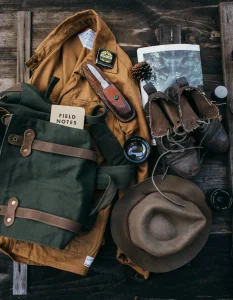Introduction: The Lure of the Outdoors
Camping isn’t just about packing a bag and heading into the woods—it’s about preparation, awareness, and respect for nature. Camping essentials go beyond just tents and backpacks; they also include knowledge, skills, and a mindful approach to the great outdoors. Without these, a fun adventure can quickly turn into an uncomfortable or even dangerous experience.
Over the past few years, the popularity of camping has skyrocketed. According to recent data, National Park visits have increased by 15% in the last five years, with more people looking to reconnect with nature and escape their daily routines. This means more beginners are venturing into the wild, often without a full understanding of what they truly need for a safe and enjoyable trip.
This guide aims to provide first-time campers with a comprehensive list of camping essentials, covering not just gear but also key practices that will ensure a memorable experience. I’ll go over the must-have equipment, from tents and sleeping bags to cooking gear and safety tools, while also emphasizing the importance of planning ahead. Following Leave No Trace principles will be at the heart of our discussion, ensuring that every camper respects and protects nature for future generations.
The right gear, combined with the right knowledge, makes all the difference. A well-prepared camper enjoys the journey without stress, stays safe in unexpected situations, and most importantly, feels a deeper connection to nature. Whether you’re setting up a tent in Yellowstone National Park or hiking through Great Smoky Mountains National Park, having the right essentials will transform your camping experience from frustrating to fantastic.
Understanding Your Adventure: Types of Camping and Essential Categories
Camping isn’t a one-size-fits-all experience. Depending on your preferences, environment, and level of experience, there are different styles of camping, each requiring specific gear and preparation.
Types of Camping
-
Car Camping – This is one of the easiest and most popular ways to camp. You drive to a designated campsite, park nearby, and set up your tent. Car camping allows you to bring extra comfort items, like larger tents, camp chairs, and even coolers, making it ideal for beginners. Popular locations for car camping include Yosemite National Park and Shenandoah National Park.
-
Backpacking – Unlike car camping, backpacking is all about carrying everything on your back. Weight is a major factor, so gear must be lightweight, compact, and efficient. Essentials include a lightweight tent, sleeping bag, and cooking system. The Appalachian Trail and John Muir Trail are famous for backpacking adventures.
-
Dispersed Camping – This form of camping is all about solitude. Instead of staying at a campground, you set up in remote areas, often on Bureau of Land Management (BLM) land or in National Forests. There are no designated campsites, so you must bring everything you need and follow Leave No Trace principles strictly.
-
Winter Camping – Camping in the snow is a unique experience but requires extra preparation. You’ll need four-season tents, insulated sleeping bags, and proper layering to stay warm. National parks like Rocky Mountain National Park offer designated winter camping spots for experienced adventurers.
-
Family Camping – Camping with kids requires additional planning and gear, including kid-friendly sleeping bags, extra snacks, and engaging activities. Many campgrounds, such as those in Acadia National Park, offer family-friendly amenities like restrooms, picnic tables, and nature programs.
picture by rachel claire
Essential Categories of Camping Gear
To make your camping trip smooth and enjoyable, you’ll need to pack the right gear based on these essential categories:
- Shelter: Tents, hammocks, tarps
- Sleeping Gear: Sleeping bags, sleeping pads, pillows, liners
- Cooking Equipment: Stoves, cookware, food storage, water filtration
- Navigation & Safety: Maps, compasses, GPS devices, first-aid kits, whistles, headlamps
- Clothing: Layering system, rain gear, durable hiking boots
- Hygiene & Sanitation: Biodegradable soap, waste disposal bags, wet wipes
- Tools & Miscellaneous: Multi-tools, pocket knives, fire starters, duct tape, repair kits
Why the Right Gear Matters
Each year, thousands of campers face injuries due to inadequate preparation. According to a study by the National Park Service, over 3,000 camping-related injuries occur annually, many of which could be prevented with the right equipment. A lack of proper footwear leads to sprains, insufficient cold-weather gear results in hypothermia, and failing to bring first-aid supplies makes minor injuries more dangerous.
Personal Tip: Before every trip, I tailor my gear list to the specific conditions I’ll face. The right equipment makes all the difference—turning a potentially tough night into a comfortable and enjoyable experience.
Shelter: Creating Your Outdoor Sanctuary
I’ll never forget the night my tent failed me. I was camping in Rocky Mountain National Park, and the weather report promised a calm evening. But nature had other plans. As the wind howled through the trees, my cheap tent buckled under the pressure. The poles snapped, the rainfly flapped wildly, and within minutes, my gear was soaked. That night, I learned a crucial lesson—the right shelter can make or break a camping trip.
Tents: Your First Line of Protection
Choosing the right tent depends on the type of camping, weather conditions, and personal comfort preferences.
✅ Common Tent Types
- Dome Tents: Easy to set up, stable in wind, and great for beginners.
- Tunnel Tents: Spacious and great for groups, but require strong anchoring.
- Geodesic Tents: Built for extreme weather, with reinforced poles for high winds.
- Ultralight Tents: Ideal for backpacking, but expensive and fragile.
✅ Key Features to Consider
- Seasonality: Three-season tents work for most trips, while four-season tents are for extreme cold and wind.
- Capacity: A two-person tent fits two snugly, but a three-person tent offers extra room.
- Weight: Lighter tents are easier to carry but may sacrifice durability.
- Ventilation: Good airflow reduces condensation and keeps the interior dry.
✅ Pros & Cons of Tents
| Pros | Cons |
|---|---|
| Protection from rain, wind, and bugs | Can be heavy for backpacking |
| Offers privacy and security | Some are tricky to set up |
| Variety of options for different needs | High-quality tents can be expensive |
Pro Tip: Always set up your tent at home before your trip to avoid frustration in the wild.
Tarps & Ground Cloths: Extra Protection
Tarps and ground cloths serve multiple purposes, from keeping the bottom of your tent dry to acting as a rain cover or sunshade.
✅ Common Uses
- Rain Protection: A tarp can be hung above your tent for extra waterproofing.
- Footprint: Placing a ground cloth under your tent prevents wear and tear.
- Sunshade: A tarp strung between trees creates a shaded cooking or relaxation area.
Setup Tip: Angle tarps slightly so rainwater runs off instead of pooling.
Hammocks & Alternative Shelters
Hammock camping has gained popularity, but it’s not for every situation.
✅ Advantages
- Lightweight and easy to carry.
- No need for level ground.
- Keeps you off wet or cold terrain.
✅ Disadvantages
- Requires sturdy trees for setup.
- Limited protection from wind and rain.
- Not ideal for cold weather without insulation.
Safety Tip: Hang hammocks no more than 18 inches off the ground to prevent injury if you fall.
Site Selection: Choosing the Perfect Spot
Picking the right campsite is just as important as choosing the right shelter.
✅ What to Look For
- A flat, dry area away from water sources.
- Protection from wind and falling branches.
- Good drainage in case of rain.
✅ Leave No Trace Guidelines
- Camp at least 200 feet away from lakes and streams to protect fragile ecosystems.
- Use existing campsites rather than creating new ones.
- Pack out all trash to keep nature pristine.
Final Tip: Always check the weather before setting up your shelter—unexpected storms can turn a great campsite into a nightmare.
Sleeping Comfort: Restorative Nights Under the Stars
I’ll never forget the night I didn’t sleep while camping in Yellowstone National Park. It was my first cold-weather trip, and I thought my basic sleeping bag would be enough. But as the temperature dropped, I shivered through the night, barely catching any rest. The next day, I felt exhausted, sluggish, and unable to enjoy the hike we had planned. That trip taught me a valuable lesson—a good sleep system is just as important as food and water when camping.
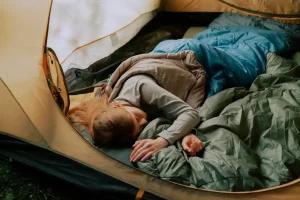
Sleeping Bags: Your Warm and Cozy Cocoon
A sleeping bag is one of the most important pieces of gear for any camper. Choosing the right one depends on temperature, insulation type, and personal comfort.
✅ Temperature Ratings:
- Summer Bags (35°F and above): Lightweight and breathable.
- Three-Season Bags (15°F to 35°F): Versatile for spring, summer, and fall.
- Winter Bags (15°F and below): Designed for extreme cold with extra insulation.
✅ Insulation Types:
- Down: Lightweight, warm, and long-lasting but loses insulation when wet.
- Synthetic: Dries faster and insulates when wet but is bulkier and heavier.
✅ Shape & Size Considerations:
- Mummy Bags: Snug fit, great for heat retention.
- Rectangular Bags: More space to move but less warmth.
- Double Bags: Great for couples but can be bulky.
Care Tip: Always store your sleeping bag loosely in a large sack to maintain insulation.
Sleeping Pads: The Secret to Comfort & Warmth
Sleeping pads do more than just add comfort—they provide insulation from the cold ground.
✅ Understanding R-Value:
- Measures how well a pad resists heat loss.
- R-Value 1-2: Best for warm weather.
- R-Value 3-4: Good for three-season use.
- R-Value 5+: Necessary for winter camping.
✅ Types of Sleeping Pads:
- Foam Pads: Affordable, durable, but less comfortable.
- Inflatable Pads: Lightweight, comfortable, but can puncture.
- Self-Inflating Pads: Balance between comfort and insulation.
- Hybrid Pads: Combine foam and air for versatility.
Pro Tip: Choose a sleeping pad with an R-value that matches the coldest conditions you expect.
Sleeping Pillows & Liners: Small Items, Big Difference
✅ Why Use a Pillow?
- Supports neck and back for better sleep.
- Prevents stiffness and discomfort.
- Compact camping pillows save space while adding comfort.
✅ Benefits of Sleeping Bag Liners:
- Add 5-15°F of warmth to your sleeping bag.
- Keep your sleeping bag cleaner.
- Available in silk, fleece, and synthetic options.
Hygiene Tip: A liner is easier to wash than a sleeping bag and helps extend its lifespan.
The Importance of a Good Night’s Sleep
Poor sleep can ruin a camping trip. Studies show that lack of sleep reduces cognitive function by 30% and increases fatigue, leading to a higher risk of accidents. If you’re planning long hikes in places like Grand Teton National Park, a quality sleep system isn’t just a luxury—it’s a necessity.
The difference between a rough night and a refreshing one comes down to preparation. Ever since that freezing night in Yellowstone National Park, I never camp without a properly rated sleeping bag, a quality pad, and a comfy pillow. When I wake up well-rested, I can fully enjoy the beauty of the outdoors—without yawning my way through the adventure!
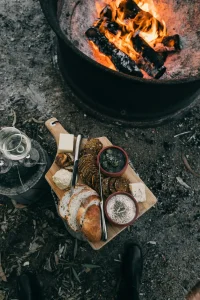
Cooking and Food: Culinary Adventures in the Wild
One of my favorite parts of camping is cooking under the open sky. There’s something magical about making a warm meal after a long day of hiking. I still remember a trip to Glacier National Park when I made the best campfire chili of my life. The smell of spices filled the air, and as we sat around the fire, sharing stories, I realized that food is more than just fuel—it’s part of the adventure.
Camping Stoves: Choosing the Right One
A good camping stove makes cooking easier, but choosing the right one depends on the type of camping you’re doing.
✅ Types of Fuel:
- Propane: Easy to use, great for car camping.
- Butane: Compact but struggles in cold weather.
- White Gas: Performs well in all temperatures, ideal for winter camping.
- Alcohol & Solid Fuel: Lightweight, best for backpacking.
✅ Stove Designs:
- Single-burner stoves: Small, portable, good for solo trips.
- Two-burner stoves: Great for cooking full meals at a campsite.
- Backpacking stoves: Ultra-lightweight and compact.
Safety Tip: Always cook in a well-ventilated area, and keep flammable materials away from the stove.
Cookware and Utensils: Packing Smart
- Lightweight cookware: Aluminum is lightweight, stainless steel is durable, and titanium is best for ultralight camping.
- Collapsible utensils: Space-saving and easy to carry.
- Cleaning supplies: A small sponge, biodegradable soap, and a cloth for drying.
Sanitation Tip: Wash dishes 200 feet away from water sources to protect the environment.
Food Planning and Storage: Keeping Meals Safe
Proper food storage is important, especially in places like Yosemite National Park, where bears are common.
Meal Planning Tips:
- Short trips: Fresh foods like eggs, bread, and veggies.
- Long trips: Dehydrated meals, instant rice, and powdered soup.
- Backpacking: High-energy, lightweight snacks like nuts, jerky, and granola.
Bear-Proof Storage:
- Use bear-proof containers or hang food in a tree (at least 10 feet high and 4 feet away from the trunk).
- Never leave food in your tent.
Water Purification: Stay Hydrated, Stay Healthy
Drinking untreated water can lead to serious illness, so always purify water before drinking.
✅ Methods:
- Filters: Remove bacteria and dirt.
- Boiling: Kills bacteria and viruses (boil for at least 1 minute).
- Chemical Treatment: Tablets or drops can disinfect water.
Pro Tip: Always carry backup purification tablets in case your filter breaks.
Favorite Camping Recipe: One-Pot Chili
One of my go-to camping meals is one-pot chili. It’s easy, filling, and packed with flavor.
Ingredients:
- 1 can of beans
- 1 can of diced tomatoes
- 1 packet of chili seasoning
- ½ lb of ground beef or veggie substitute
- 1 cup of water
Steps:
- Brown the meat in your camping pot.
- Add tomatoes, beans, seasoning, and water.
- Simmer for 15 minutes, stirring occasionally.
- Enjoy by the campfire with some bread!
Why Food Safety Matters
Did you know that foodborne illnesses are one of the most common health issues while camping? According to studies, about 1 in 6 campers experience food-related illnesses due to improper storage or handling. Symptoms like stomach pain and dehydration can ruin a trip.
How to Prevent Foodborne Illness:
- Keep perishable food in a cooler with ice packs.
- Wash hands and cookware before and after handling raw food.
- Cook meats to the proper temperature (use a meat thermometer if possible).
Cooking in the wild is one of the best parts of camping. With the right gear and planning, you can enjoy delicious meals while staying safe. Whether you’re making a simple soup or grilling by the fire, good food makes every adventure better.
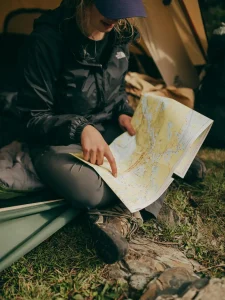
Navigation and Safety: Staying Found and Prepared
I’ll never forget the time I got turned around while hiking in Rocky Mountain National Park. I had a map, but I didn’t know how to read it properly. My GPS lost signal, and suddenly, every tree looked the same. Thankfully, I had a whistle and a basic understanding of navigating by the sun, so I made it back to camp. That day, I learned an important lesson: navigation and safety are just as important as packing the right gear.
Navigation: Finding Your Way in the Wild
Getting lost is one of the biggest dangers in the outdoors. Here’s how to stay on track:
✅ Map and Compass Basics:
- Always carry a topographic map of the area.
- Use a compass to determine direction—line it up with your map.
- Learn how to identify landmarks like rivers, mountains, and trails.
✅ GPS Devices: A Useful but Imperfect Tool
- Handheld GPS devices and smartphone apps can help, but they aren’t foolproof—batteries die and signals get lost.
- Always have a paper map and compass as backup.
✅ Reading the Land and Weather:
- Watch for changes in terrain—a sudden dip might mean a creek, while an open valley can lead to a pass.
- Check weather patterns before heading out. Dark clouds mean rain, sudden temperature drops can mean a storm, and strong winds may signal changing conditions.
First-Aid and Emergency Preparedness
A small injury can become serious fast in the backcountry. A good first-aid kit and knowledge can make all the difference.
Essential First-Aid Kit Items:
- Bandages and gauze
- Antiseptic wipes and ointment
- Tweezers (for splinters or ticks)
- Pain relievers (like ibuprofen)
- Allergy medication
- Emergency blanket
Pro Tip: Learn basic first-aid skills like how to treat burns, stop bleeding, and wrap a sprained ankle.
Emergency Communication Tools:
- Whistle: Three short blasts is the universal distress signal.
- Satellite Messenger: Works where phones don’t (great for backcountry hikes in Yellowstone National Park).
- Signal Mirror: Can help rescuers locate you.
Weather Awareness: Be Ready for Anything
Sudden storms, extreme heat, or unexpected snowfall can turn a trip dangerous.
- Check the forecast before your trip.
- Pack for temperature drops—even in summer, nights can get cold in places like Grand Canyon National Park.
- Watch for weather changes—fast-moving clouds, sudden wind shifts, or a drop in temperature can mean a storm is coming.
Wildlife Safety: Respecting Nature
Wild animals are amazing to see, but it’s important to keep a safe distance.
✅ Bear Safety:
- Store food in bear-proof containers or hang it in a tree.
- Carry bear spray in bear country.
- Never run if you see a bear—back away slowly.
✅ Snake Safety:
- Watch where you step and avoid tall grass.
- If bitten, stay calm and seek medical help.
✅ Insect Protection:
- Wear long sleeves and pants.
- Use insect repellent to prevent bites.
- Check for ticks after hiking.
Why First-Aid Training is a Must
I highly recommend taking a wilderness first-aid course. It teaches how to handle emergencies when help is far away. Even a simple skill—like knowing how to clean a wound properly—can prevent serious infections.
Staying safe outdoors isn’t just about luck; it’s about preparation. By learning navigation skills, carrying first-aid essentials, and understanding wildlife behavior, you can focus on enjoying the adventure instead of worrying about what could go wrong.
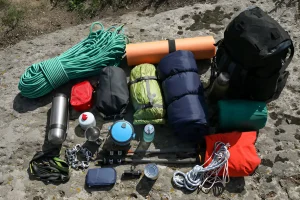
Clothing and Personal Items: Comfort and Functionality
I’ll never forget the time I went camping in Glacier National Park and made a rookie mistake—I packed all the wrong clothes. During the day, I was sweating in a thick jacket, and at night, I was freezing because I didn’t have the right layers. That trip taught me an important lesson: wearing the right clothes can make or break your camping experience.
The Layering System: Dressing for the Outdoors
The key to staying comfortable in any weather is layering. Here’s how it works:
1️⃣ Base Layer (Moisture Management):
- Wicks sweat away from your skin.
- Best materials: Merino wool, synthetic fabrics (avoid cotton—it stays wet!).
2️⃣ Insulating Layer (Warmth):
- Traps body heat.
- Best materials: Fleece, down, or synthetic insulation.
3️⃣ Outer Layer (Protection):
- Shields against wind, rain, and snow.
- Best materials: Waterproof and breathable fabrics like Gore-Tex.
Footwear: Happy Feet, Happy Camper
Boots vs. Shoes: Choose based on terrain. Hiking boots offer ankle support, while trail runners are lightweight for easy hikes.
Break Them In: Never wear brand-new boots on a trip—blisters will ruin your adventure.
Sock Selection: Wool or synthetic socks help prevent blisters and keep feet dry.
Personal Items: The Small Gear That Makes a Big Difference
Lighting: A headlamp is hands-free and perfect for setting up camp in the dark.
Hygiene: Biodegradable soap, hand sanitizer, and a small towel help you stay fresh.
Multi-Tools & Knives: Useful for cutting rope, preparing food, and handling unexpected tasks.
Leave No Trace: Keep It Clean
Following Leave No Trace principles means packing out everything you bring in—including hygiene products. Use reusable bottles instead of disposable ones, and always dispose of waste properly.
The right clothing and gear will keep you comfortable and safe, letting you focus on the beauty of the outdoors instead of worrying about being too cold, wet, or uncomfortable.
Gear Checklist: Your Essential Packing Guide
I’ll never forget my first camping trip to Rocky Mountain National Park. I thought I had everything, but when I arrived, I realized I had forgotten a headlamp and a warm sleeping bag. That night was long and cold, and I learned the hard way that a detailed checklist is the key to a smooth camping experience.
Essential Camping Gear Checklist
Shelter & Sleep:
✅ Tent (with stakes & guylines)
✅ Ground tarp or footprint
✅ Sleeping bag (rated for the expected temperature)
✅ Sleeping pad or air mattress
✅ Camping pillow
Cooking & Food Storage:
✅ Camping stove & fuel
✅ Lightweight cookware (pot, pan, utensils)
✅ Reusable water bottle or hydration system
✅ Food storage containers or bear canister
✅ Biodegradable soap & sponge
Navigation & Safety:
✅ Map & compass (or GPS device)
✅ First-aid kit
✅ Headlamp (with extra batteries)
✅ Multi-tool or knife
✅ Emergency whistle
Clothing & Personal Items:
✅ Layered clothing (base, insulation, outer layer)
✅ Sturdy hiking boots or trail runners
✅ Hygiene kit (toothbrush, biodegradable soap, hand sanitizer)
✅ Sunscreen & bug spray
Packing Tips for a Stress-Free Trip
- Pack by category: Keep items organized in dry bags or stuff sacks.
- Distribute weight: Heavier items should be in the middle of your backpack for better balance.
- Use a checklist: Print or save this list so you don’t forget the essentials!
The right gear makes all the difference. Whether you’re camping in Yellowstone National Park or hiking in Zion National Park, being well-prepared ensures a safe and fun adventure.
Pros and Cons: Investing in Your Camping Experience
I still remember the time I bought my first budget-friendly tent for a weekend in Shenandoah National Park. The forecast looked clear, so I wasn’t too worried—until an unexpected storm rolled in. That night, I learned firsthand that waterproofing matters. My tent leaked, my sleeping bag got soaked, and I spent a miserable, shivering night. From that moment on, I understood the value of investing in quality gear.
Pros of Investing in Good Camping Gear
✔ Comfort & Safety: A well-made sleeping bag, tent, and stove can make or break a trip. Staying warm, dry, and well-fed leads to a much more enjoyable experience.
✔ Better Experience: High-quality gear is often easier to set up, more durable, and performs well in harsh conditions.
✔ Long-Term Savings: While top-tier equipment costs more upfront, it lasts for years, saving money in the long run.
Cons of Investing in Expensive Gear
❌ High Initial Cost: Premium equipment, like a down sleeping bag or ultralight tent, can be pricey for beginners.
❌ Over-Packing Risk: It’s easy to get carried away and bring too much, making your backpack unnecessarily heavy.
Finding the Right Balance
Not everything needs to be top-of-the-line. I recommend investing in key items—like a good tent and sleeping pad—while finding budget-friendly options for things like cooking gear. A mix of quality and affordability ensures a comfortable, safe, and enjoyable camping experience for years to come.
Conclusion: Embracing the Adventure
Camping is more than just a trip—it’s an opportunity to reconnect with nature, challenge yourself, and create unforgettable memories. Whether you’re setting up camp in Yosemite National Park or hiking through the Great Smoky Mountains, having the right camping essentials makes all the difference between a stressful trip and an amazing experience.
Preparation is key. From choosing the right tent to packing a reliable sleeping bag and mastering outdoor cooking, a little planning ensures comfort, safety, and fun. But don’t let the details overwhelm you—every great camper starts as a beginner.
So go ahead, take the leap! The great outdoors is waiting for you. What’s your most memorable camping experience? Or do you have a question before your first trip? Share your thoughts in the comments—I’d love to hear from you!
FAQ
1. What are the basic camping essentials every beginner needs?
The basics include a tent, sleeping bag, cooking gear, first-aid kit, navigation tools, proper clothing, and a headlamp for safety and comfort.
2. How do I choose the right tent for my trip?
Consider the seasonality, capacity, weight, and ventilation. A 3-season tent is best for most beginners, offering good protection and breathability.
3. What’s the best way to stay warm while sleeping outdoors?
Use a sleeping bag rated for the lowest expected temperature, pair it with a sleeping pad for insulation, and wear layered clothing to trap heat.
4. How do I cook food while camping?
A portable camping stove is the most reliable option. Make sure to pack lightweight cookware, utensils, and safe food storage to avoid attracting wildlife.
5. How do I find safe drinking water while camping?
Use water purification methods like filters, purification tablets, or boiling to ensure clean drinking water and prevent illness.
6. What should I wear for a camping trip?
Dress in layers to stay comfortable in changing temperatures. A moisture-wicking base layer, insulating middle layer, and waterproof outer layer work best.
7. What’s the best way to pack efficiently for camping?
Follow a gear checklist, use compression bags for clothing, and distribute weight evenly in your backpack for comfort during hikes.
8. How do I stay safe while camping in bear country?
Store food in a bear-proof container or hang it from a tree, avoid cooking near your tent, and carry bear spray for extra protection.
9. What are the most common mistakes beginner campers make?
Overpacking, underestimating weather conditions, bringing the wrong sleeping gear, and not following Leave No Trace principles are common mistakes.
10. How can I make my first camping trip stress-free?
Plan ahead, choose a beginner-friendly campground, test your gear at home, and start with a short trip to gain confidence.

